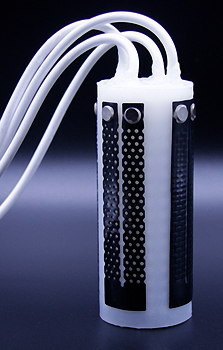Soft robots, made from flexible materials, are being championed as safer, more adaptable alternatives to traditional rigid robots. But giving autonomous control to these deformable robots is a “monumental” task, according to the MIT researchers, because they can move in almost any direction at any time. That makes it difficult to train planning and control models that could automate their movements.
Traditional methods for achieving autonomous control use multiple motion-capture cameras that provide feedback about a robot’s movement and position in 3D. But these systems are impractical for soft robots in real-world applications.
The MIT researchers have therefore developed a system of soft sensors that cover a robot’s body to give it awareness of its motion and position. A deep-learning model analyses the data to estimate the robot’s 3D configuration. The researchers validated their system on a soft robotic arm resembling an elephant trunk, that can predict its own position as it swings around and extends autonomously.
“We’re sensorising soft robots to get feedback for control from sensors, not vision systems, using a very easy, rapid method for fabrication,” explains Ryan Truby, from MIT’s Computer Science and Artificial Laboratory (CSAIL), who co-authored a paper on the development. “We want to use these soft robotic trunks, for instance, to orient and control themselves automatically, to pick things up and interact with the world. This is a first step toward that type of more sophisticated automated control.”

The MIT researchers created their “sensorised” robot skin from sheets of conductive silicone.Photo: Ryan Truby, MIT CSAIL
To create his sensors, Truby laser-cut rectangular strips of conductive silicone sheets into patterns to make them flexible and stretchable.
The researchers now want to explore more sensitive sensor designs and to develop new models and deep-learning methods to reduce the training required for the soft robots. They also hope to refine their system to better capture the robot’s full dynamic motions.
One future aim is to help make artificial limbs that can handle and manipulate objects more dexterously.

